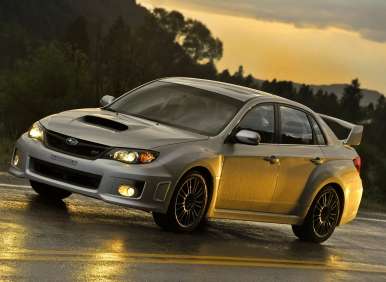Recent Articles
Popular Makes
Body Types
2013 Subaru Impreza WRX STi Road Test And Review
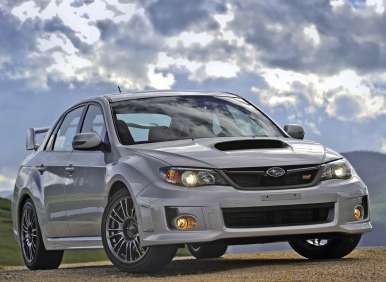
Not so long ago, the Subaru WRX was considered “exotic” here in America.
Originally introduced in Japan in 1992, the WRX was not initially offered on this continent. However, as the Subaru’s rep grew when it started winning rallies and appearing in video games, American enthusiasts clamored hungrily for the “unobtainable” WRX. So in 2001, Subaru finally offered the WRX here as a 2002 model.
Even before the development of the WRX however, back in the late 1980s, Subaru created Subaru Tecnica International (STI) to coordinate development for its motorsports activities. STI also created higher-performance street versions of the WRX, which led to the development of the Impreza WRX STi.
In 2004, a WRX STi was offered in America for the first time. However, that car was set up more like the rally cars on which it was based, than it was optimized for the street. Consequently, it suffered somewhat when asked to perform vigorously on pavement. Then, for the 2011 model year — when the current STi was introduced — Subaru finely calibrated more specifically for exceptional street performance.
And, they finally got it right.
2013 Subaru Impreza WRX STi Road Test And Review: Models & Prices
For 2013, Subaru is offering its flagship performance car in two body styles (sedan and five-door hatchback) and two states of trim, although only one of the two trim levels are offered with the five-door hatchback body. Christened STi and STi Limited, the Limited trim package can be had only as a four-door sedan.
The $34,925 WRX STi’s feature set is comprised of a set of xenon headlights and heated seats with faux-suede and leather upholstery. The STi also gets front and rear limited-slip differentials, 18-inch BBS wheels, Brembo brakes, SI-Drive vehicle settings, and an even more aggressively tuned suspension system than the one fitted to the WRX. It gets a bigger hood scoop than the one on the WRX as well.
The hatchback WRX STi gets a set of foglights as part of its base packaging, while the sedan only gets them as part of the $37,645 WRX STi Limited trim package. The rest of sedan’s Limited package is comprised of a unique set of 18-inch wheels, a sunroof, and leather upholstery for the seats.
A touchscreen navigation system is available on all WRX and STI models, which also includes voice activation, real-time traffic, text messaging capabilities, and satellite radio.
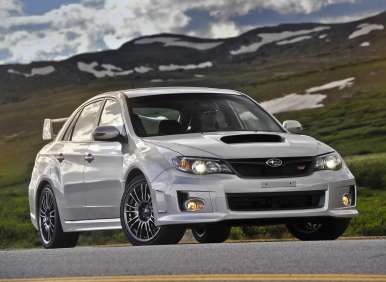
2013 Subaru Impreza WRX STi Road Test And Review: Design
With the 2011 model refresh Subaru also reintroduced a four-door sedan in STi trim after having run only a five-door hatchback since 2008. To our eye, the STi sedan is better looking than the five-door. Either way though, with its wide track and flared fenders, the STi looks like a machine to be taken seriously.
We like the STi’s aggressive front styling as well. The Subaru’s blacked out grille and large air intakes give the STi a “get-out-of-my-way” glower. Even the STi’s huge rear wing has “grown” on us. Particularly since it no longer severely obstructs rearward vision the way it did in earlier versions of the car. However, if Subaru had chosen to offer the STi without it, we’d have gone that route.
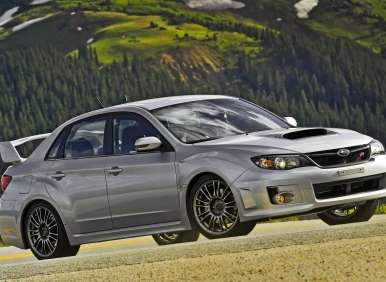
2013 Subaru Impreza WRX STi Road Test And Review: Comfort & Cargo
If you're getting into a Subaru STi looking for an abundance of creature comforts, you might do better to hop out and march yourself across the showroom to a copy of the Legacy GT sedan (similar performance, more luxury features).
Rather than showing, the STi is all about going, with not a lot of attention paid to being. It’s a stripped down racer for the street and makes no apologies whatsoever for that fact. Inside the WRX STi, if you don’t sit on it or grasp it to control the vehicle, you’ll find it finished in hard plastic.
On the other hand, being based on the Impreza endows the Subaru STi with way more interior room than most compact cars with this much performance potential allow. Four adults can roll STi in reasonable comfort. Plus, the hatchback design of the five-door model affords an amazing 19 cubic feet of cargo space. The sedan’s trunk offers 11.3 cubic feet.
In this regard, the Subaru is quite remarkable.

2013 Subaru Impreza WRX STi Road Test And Review: Features & Controls
Bluetooth and USB connectivity are highlights of the Subaru’s audio system. And while these are cutting edge tools, the double-DIN device in which they’re housed looks more like a refugee from a J.C. Whitney catalog — circa 1980. And frankly, it sounds like one too.
But again, if you’re into all of that, you really need to be looking at a Legacy GT.
The navigation system is offered as a $1000 option, and even though it includes satellite radio, we have to recommend against it. The thing is a nightmare to use, and these days, with Bluetooth, Pandora and a smartphone, you really don’t need the hassle of it.
Aside from that, the simplicity of the WRX STi’s packaging is highly conducive to performance driving. All the controls are really simple to use and placed well for intuitive operation. You’ll find a grand total of six dials on the center console — two for the radio, three for the climate control system, and one for the drive select system.
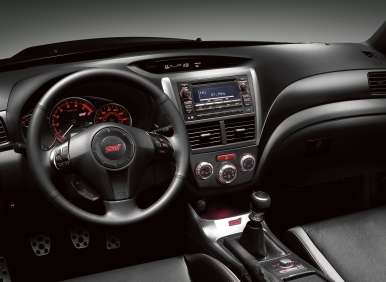
2013 Subaru Impreza WRX STi Road Test And Review: Safety And Ratings
In NHTSA’s crash testing the Subaru returned a rating of four out of five stars overall, as well as in frontal and side impacts. The IIHS rates the STi “Good” (its highest rating) in frontal offset, side impact, and roof strength testing. Standard safety gear includes stability and traction control, antilock disc brakes, hill-hold assist, front side airbags, and side curtain airbags. Electronic brake force distribution and brake assist are fitted to the 2013 WRX STi as well.
Front and rear crumple zones; front seat side pelvis/torso airbags and side-curtain airbags are also standard equipment. Subaru’s Advanced Frontal Airbag System features a passenger side front seat sensor module capable of determining whether a child or an adult occupies the seat and controls airbag deployment accordingly. The STi uses three-point seatbelts at all seating positions. Further, the front seats get height-adjustable seatbelts with electrically triggered pre-tensioners and force limiters.
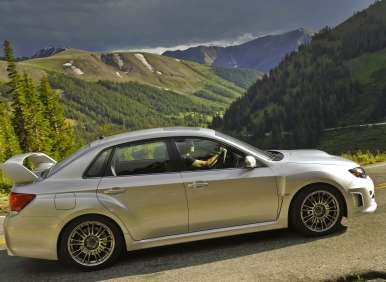
2013 Subaru Impreza WRX STi Road Test And Review: Engine / Fuel Economy
The WRX STi engine is a 2.5-liter turbocharged and intercooled four-cylinder horizontally opposed powerplant with Subaru’s Dual Active Valve Control System (in other words, variable intake and exhaust valving). The STi’s turbocharger pumps out some 14.7-PSI of boost. The exhaust system is comprised of a high-flow rear catalytic converter, a low backpressure muffler, and two sets of dual-outlet chrome tailpipes.
Thanks to all of this, the STi driver enjoys 305 horsepower at 6,000 rpm and 290 ft-lbs of torque at 4,000 rpm. Given the STi Limited’s curb weight of 3,417 pounds, good performance is expected. And indeed, in our testing, we routinely recorded sub five-second runs to 60 miles per hour from a standstill.
The engine’s power is transmitted to all four wheels via a six-speed manual transmission; neither an automatic nor a direct-shift gearbox is available. The driveline incorporates Incline Start Assist to momentarily prevent the vehicle from rolling backward when being driven away from a stop on a hill.
The STi powertrain also uses a driver controlled center differential (DCCD) enabling you to manually bias torque between the front and rear wheels based on the driving situation. While set up to function automatically, the driver can select the parameters within which it functions.
The standard Auto mode varies the front/rear torque distribution via the limited-slip differential in response to vehicle acceleration, deceleration, steering angle, cornering force, and wheel slippage to optimize traction. The “Auto (-)” mode sets the torque bias more to the rear to make the STi behave more like a high performance rear-wheel drive car. The Auto (+) mode fully employs the limited slip differential to apportion torque to all four wheels to improve traction on slippery surfaces. There is also a manual mode, which permits the driver to set the car’s torque apportionment up to his or her own particular taste and lock that setting in regardless of conditions.
The Subaru Intelligent Drive (SI-DRIVE) system enables the driver to use a rotary dial on the center console to regulate the engine control module and the electronic throttle control system through three selectable modes; “Intelligent,” “Sport”, and “Sport Sharp”. The Intelligent mode is more laid back for day-to-day driving. The “Sport” mode advances throttle response, giving the car a more energetic feel. “Sport Sharp” advances throttle response even more for all-out performance.
While we get the potential for the DCCD, the SI-DRIVE system strikes us as a gimmick. Seriously, why make anyone fiddle with a dial? If the STi is supposed to be a performance car, just set it to the sharpest throttle response possible during manufacturing at the factory and be done with it — OK?
Fuel economy for the STi is rated at 17 miles per gallon in the city, 23 on the highway, and 19 combined on premium-unleaded fuel.
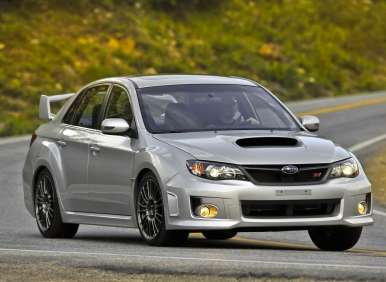
2013 Subaru Impreza WRX STi Road Test And Review: Driving Impressions
Based as they were on rally cars, the first STi models shipped here came up somewhat lacking when asked to perform vigorously on the street. Yeah, they were fast; and yeah, they handled better than the average car. But the compliance built into their suspension systems to deal with the vagaries of rallying left those STi models less than razor sharp on pavement.
For the 2011 redesign, Subaru recalibrated the STi suspension system in an effort to give the performance car more bite in the corners. Subaru’s chassis engineers also sought to improve overall stability, sharpen steering, minimize understeer, and reduce body roll. Stiffer springs, a lower ride height, larger sway bars, stiffer rear bushings, and redesigned front bushings (tagged “pillow ball” bushings by Subaru) comprised the hardware upgrades specified to accomplish these tasks.
Sure enough, if you drive a 2010 STi and a 2013 STi back-to-back, the difference in handling is readily discernable. The 2013 turns in more sharply, corners more flatly and just generally feels more capable on the track. The car exhibits heightened response to steering inputs and its willingness to dive deeply into corners at great speed is absolutely delightful.
With a set of 13-inch discs up front being clamped upon by four piston Brembo calipers and 12.6-inch discs at the rear, the WRX STi demonstrates exceptional braking prowess. Further, the system is fade resistant and readily modulated. Setting the STi up to enter a turn is a snap.
Once you’re in the corner, grip is outstanding, and if the car starts to oversteer on you, all you have to do is bury your foot deeper into the throttle to give the all-wheel drive system more bite and your line tightens nicely.
The STi is so easy to drive fast, it’s almost scary.
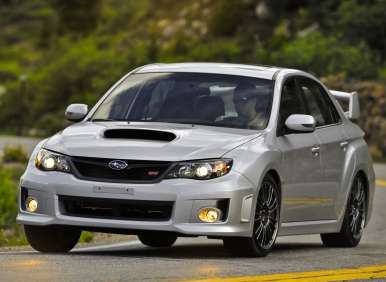
2013 Subaru Impreza WRX STi Road Test And Review: Final Thoughts
By all measures, the 2013 Subaru WRX STi is an exciting car and given the enjoyment we derived from it, if there were no other considerations, we’d endorse the STi heartily.
Thing is, there’s another consideration.
For the way most people drive, the standard WRX is more than sufficient.
With it priced approximately $8500 less than the STi, we’re really struggling to justify the purchase of the STi, particularly since there is no real difference in the look of the two cars. You see, the wide-bodied look for both STi sedan and five-door also grace the standard WRX. Plus, the standard WRX comes with a more reasonable-looking rear spoiler.
Yes, you'll give up 40 horsepower and 46 ft-lbs of torque to the STi, but remarkably, the WRX consistently tests quicker to 60 than the STi. Here’s the dirty little secret y’all; the gear that truly makes the STi the STi really only comes into play in competition situations. So, you gotta ask yourself; how often am I going to be doing that? In all honesty, urban drivers looking for the smart move should get a WRX instead.
There is yet another consideration; with the recent introduction of an all-new Impreza model (the car upon which the WRX STi is based) there is a new WRX (as well as a new WRX STi) just around the corner. Long story short, 2013 marks the swan song for this generation of the WRX STi. If you’ve got your heart absolutely set on this version of the car, feel free to use that info to bargain your dealer down on the price.
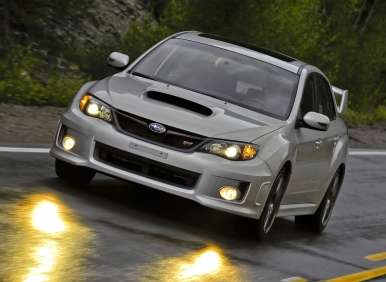
2013 Subaru Impreza WRX STi Road Test And Review: Pros And Cons
• Strong performance
• Rally car good looks
• Surprising interior and cargo capacity
• High safety ratings
• Minimal creature comforts
• Plastic-heavy interior trim
• Base WRX offers competitive performance at a lower price
